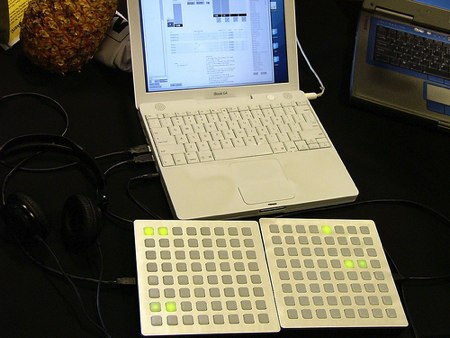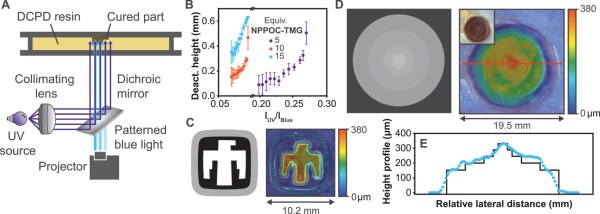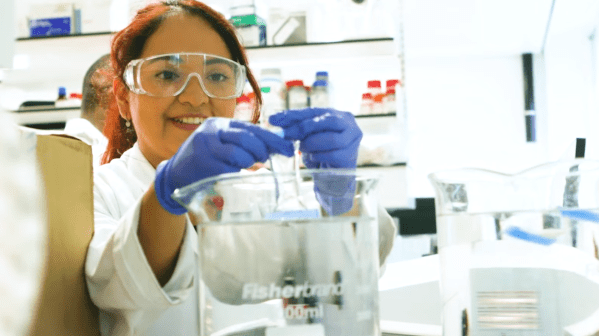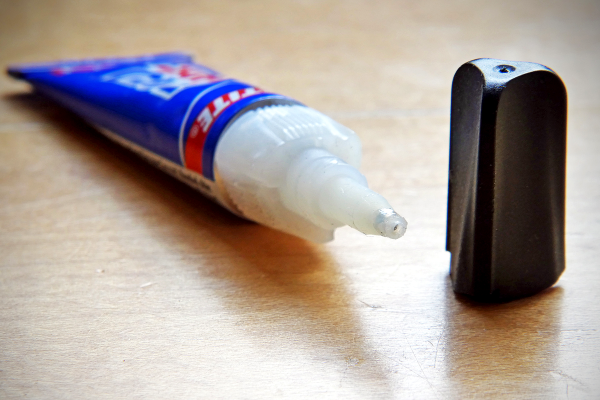
The people from the Monome project are out in full force at the Faire. They’ve got five of the 8×8 pads hooked up for people to play with. The first two pictured above actually work together as a 16 step loop system. There’s also one hooked up as a mixer and another as a drum machine. The fifth one is showing pixelated video from an iSight. The box is really well built. The $500 price point has shocked a lot of people, but it’s really unavoidable since they’re only doing a 200 device run. Something I hadn’t realized before is that the buttons are unique to the device, not off the shelf parts. The button is really a rubber cap that sits over the LED and has a conductive ring at the base. I hope they post a schematic for their 8×8 matrix controller so that anyone could build one. Here are a few more pictures: one, two, three.
Hack Media: Monome

Stop. Watch the video. Monome is an 8×8 grid of backlit buttons for music control. That’s pretty much it. The demo video does an awesome job showing some of the possibilities and I’m sure there will be many interesting developments in the future. I’d love to see what adding a second color for feedback would do.
Will O’Brien from Engadget and I will be attending Make Faire next weekend, where you’ll be able to see and play with the Monome first-hand. We hope to see some of you there.
[via Create Digital Music and Music Thing]
Dual-Wavelength SLA 3D Printing: Fast Continuous Printing With ROMP And FRP Resins
As widespread as 3D printing with stereolithography (SLA) is in the consumer market, these additive manufacturing (AM) machines are limited to a single UV light source and the polymerization of free-radical polymerization (FRP) resins. The effect is that the object is printed in layers, with each layer adhering not only to the previous layer, but also the transparent (FEP or similar) film at the bottom of the resin vat. The resulting peeling of the layer from the film both necessitates a pause in the printing process, but also puts significant stress on the part being printed. Over the years a few solutions have been developed, with Sandia National Laboratories’ SWOMP technology (PR version) being among the latest.
Unlike the more common FRP-based SLA resins, SWOMP (Selective Dual-Wavelength Olefin Metathesis 3D-Printing) uses ring-opening metathesis polymerization (ROMP), which itself has been commercialized since the 1970s, but was not previously used with photopolymerization in this fashion. For the monomer dicyclopentadiene (DCPD) was chosen, with HeatMet (HM) as the photo-active olefin metathesis catalyst. This enables the UV-sensitivity, with an added photobase generator (PBG) which can be used to selectively deactivate polymerization.
Common Enzyme Breaks Down PLA Fast
The global issue of plastic waste has prompted scientists to seek innovative solutions for recycling. Single-use plastics, notorious for their environmental impact, require new methods for efficient and sustainable management. For some common plastics, though, salvation could be at hand, with researchers identifying a common enzyme that can be used to break them down fast.
Researchers at King’s College London have discovered an enzyme used in laundry detergents that can break down PLA plastics within 24 hours, using a little heat as an aid. Normally, this is achieved via composting methods that take weeks or months. This method transforms the plastics back into their original chemical components, offering a rapid and eco-friendly recycling process. The monomers can then be reused for manufacturing new plastic items.
One wonders if this could also be used in another way – perhaps in a multimaterial printer, allowing PLA to be used for supports and then broken down. It’s probably not that necessary, given other degradable materials exist, but it’s something to think about.
This project is a significant leap forward in recycling technology, showcasing the potential for enzymes to revolutionize how we handle plastic waste. It could also be a great way to recycle all those errant deformed Pikachus that keep ending up in your hackerspace’s 3D-printing waste basket. In any case, plastic waste is a problem the world needs to solve, and quickly, because it’s not going anywhere any time soon. Video after the break.
Tech In Plain Sight: Super Glue
Many inventions happen not by design but through failure. They don’t happen through the failure directly, but because someone was paying attention and remembered the how and why of the failure, and learns from this. One of these inventions is Super Glue, the adhesive that every tinkerer and engineer has to hand to stick pretty much anything to anything, quickly. Although it was a complete failure for the original uses it was developed for, a chemist with good memory and an eye for a helpful product created it in a process he described as “one day of synchronicity and ten years of hard work.”
Super Glue was initially invented in 1942, when the chemist Harry Coover was working on a team trying to develop a clear plastic gun sight that would be cheaper than the metal ones already in use. The team cast a wide net, trying a range of new materials. Coover was testing a class of chemicals called cyanoacrylates. They had some promise, but they had one problem: they stuck to pretty much everything. Every time that Coover tried to use the material to cast a gun sight, it stuck to the container and was really hard to remove.
When the samples he tried came into contact with water, even water vapor in the air, they immediately formed an incredibly resilient bond with most materials. That made them lousy manufacturing materials, so he put the cyanoacrylates aside when the contract was canceled. His employer B. F. Goodrich, patented the process of making cyanoacrylates in 1947, but didn’t note any particular uses for the materials: they were simply a curiosity.
It wasn’t until 1951 when Coover, now at Eastman Kodak, remembered the sticky properties of cyanoacrylates. He and his colleague Fred Joyner were working on making heat-resistant canopies for the new generation of jet fighters, and they considered using these sticky chemicals as adhesives in the manufacturing process. According to Coover, he told Joyner about the materials and asked him to measure the refractive index to see if they might be suitable for use. He warned him to be careful, as the material would probably stick in the refractometer and damage it. Joyner tested the material and found it wasn’t suitable for a canopy but then went around the lab using it to stick things together. The two realized it could make an excellent adhesive for home and engineering use. Continue reading “Tech In Plain Sight: Super Glue”
Two-Dimensional Polymer Is A New Ultra-Strong Material
Plastics, by and large, are well-understood materials. Not as strong as most metals, but often much lighter, these man-made polymers have found innumerable applications that have revolutionized the way we live. The properties of plastics have been improved in many ways over the years, with composite materials like fiberglass and carbon fiber proving to have strength and lightness far beyond the simple properties of basic polymers alone.
However, a group of engineers at MIT have been working on a revolutionary type of polymer that promises greater strength then ever before while remaining remarkably light weight. It’s all down to the material’s two-dimensional molecular structure, something once thought to be prohibitively difficult in the world of polymer science.
Continue reading “Two-Dimensional Polymer Is A New Ultra-Strong Material”
As Light As Plastic; As Strong As Steel
Chemical engineers at MIT have pulled off something that was once thought impossible. By polymerizing material in two different directions at once, they have created a polymer that is very strong. You can read a pre-print version of the paper over on Arxiv.
Polymers owe many of their useful properties to the fact that they make long chains. Molecules known as monomers join together in strings held together by covalent bonds. Polymer chains may be cross-linked which changes its properties, but it has long been thought that material that had chains going through the X and Y axis would have desirable properties, but making these reliably is a challenge.
Part of the problem is that it is hard to line up molecules, even large monomers. If one monomer in the chain rotates a bit, it will create a defect in the 2D structure and that defect will grow rapidly as you add more monomers. The new technique is relatively easy to do and is irreversible which is good because reversible chains tend to have undesirable characteristics like low chemical stability. Synthesis does require a few chemicals like melamine, calcium chloride, pyridine, and trimesic acid. Along with N-Methyl-2-pyrrolidone, the mixture eventually forms a gel. The team took pieces of gel and soaked it in ethanol. With some filtering, ultrasonics, centrifuging, and washing with water and acetone, the material was ready for vacuum drying and was made into a powder.
The powder is dissolved in acid and placed on a spinning silicon wafer to form a polymerized nanofilm. Other 2D films have been produced, of course, such as graphene, but polymer films may have a number of applications. In particular, in contrast to conventional polymers, sheets of this material are impermeable to gas and liquid, which could make it very useful as a coating.
According to the MIT press release, the film’s elastic modulus is about four and six times greater than that of bulletproof glass. The amount of force required to break the material is about twice that of steel. It doesn’t sound like this material will be oozing out of our 3D printers anytime soon. But maybe one day you’ll be able to get 2D super-strong resin.
For all their faults, conventional polymers changed the world as we know it. Some polymers occur naturally, and some use natural ingredients, too.















